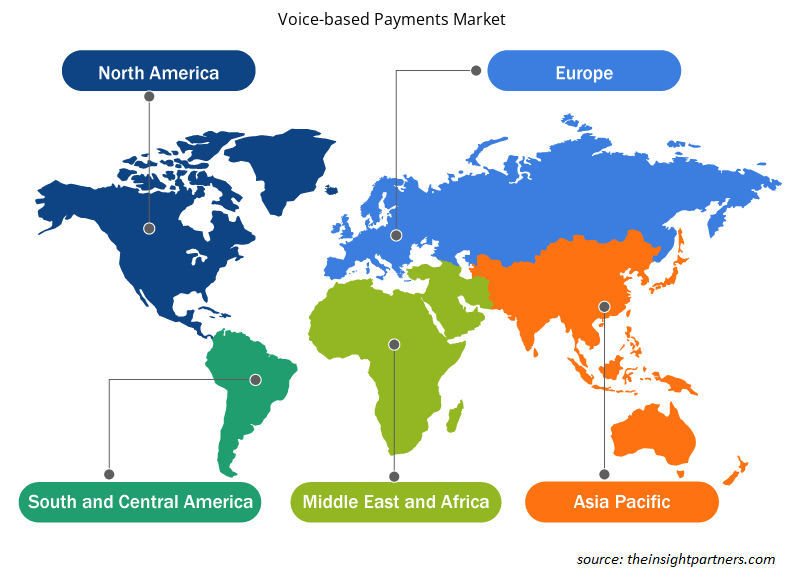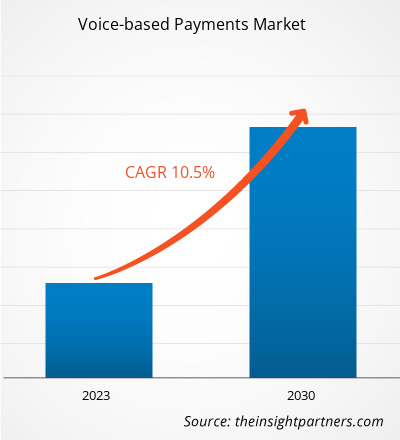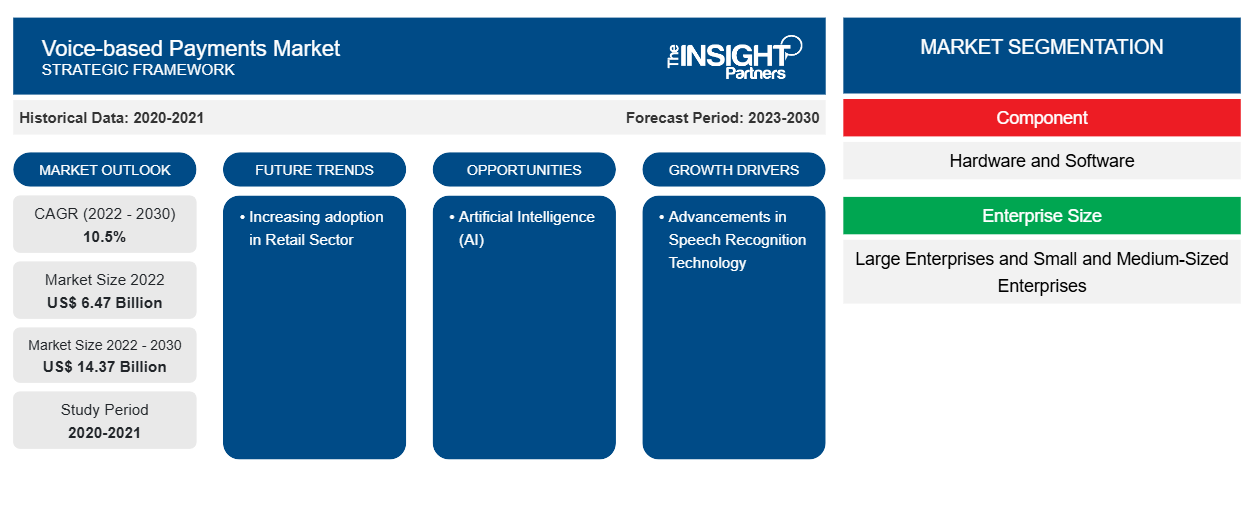Le dimensioni del mercato dei pagamenti vocali sono state valutate a 6,47 miliardi di dollari nel 2022 e si prevede che raggiungeranno i 14,37 miliardi di dollari entro il 2030; si stima che registrerà un CAGR del 10,5% dal 2022 al 2030. I progressi nel riconoscimento vocale automatico (ASR), nell'apprendimento automatico (ML) e nella comprensione del linguaggio naturale (NLU) rimarranno probabilmente le principali tendenze del mercato dei pagamenti vocali.
Analisi di mercato dei pagamenti vocali
Il mercato dei pagamenti vocali ha assistito a una crescita significativa negli ultimi anni, guidata da numerose soluzioni di commercio vocale da parte dei fornitori di servizi di pagamento. Di conseguenza, il settore si sta espandendo e sempre più clienti stanno diventando interessati alle alternative di pagamento vocale. Con l'adozione di soluzioni di pagamento vocali, le aziende possono soddisfare la crescente domanda di esperienze di pagamento intuitive e senza attriti, migliorando la soddisfazione del cliente e potenzialmente aumentando i tassi di conversione. Inoltre, questa tecnologia può semplificare i processi di pagamento interni, offrendo alle aziende un modo più efficiente e automatizzato per gestire le transazioni finanziarie.
Panoramica del mercato dei pagamenti vocali
I pagamenti vocali si riferiscono a un metodo di esecuzione di transazioni finanziarie tramite comandi o istruzioni vocali, in genere tramite dispositivi abilitati alla voce o assistenti digitali. Questa tecnologia consente agli utenti di effettuare pagamenti, avviare trasferimenti o eseguire altre transazioni monetarie utilizzando la propria voce anziché i tradizionali input manuali, come digitare o cliccare. Inoltre, i pagamenti vocali possono essere integrati in varie piattaforme, tra cui applicazioni mobili, assistenti virtuali o dispositivi intelligenti, consentendo alle aziende di offrire un'ampia gamma di opzioni di pagamento ai propri clienti. Questa tecnologia spesso incorpora robuste misure di sicurezza, come protocolli di autenticazione e crittografia, per garantire la privacy e la protezione delle informazioni finanziarie sensibili.
Personalizza questo report in base alle tue esigenze
Riceverai la personalizzazione gratuita di qualsiasi report, comprese parti di questo report, o analisi a livello nazionale, pacchetto dati Excel, oltre a usufruire di grandi offerte e sconti per start-up e università
-
Scopri le principali tendenze di mercato in questo rapporto.Questo campione GRATUITO includerà analisi di dati che spaziano dalle tendenze di mercato alle stime e alle previsioni.
Driver e opportunità del mercato dei pagamenti vocali
Progressi nella tecnologia di riconoscimento vocale per favorire il mercato
Con l'aumento dell'uso di smart speaker, smartphone e altri dispositivi abilitati alla voce nelle case, sempre più consumatori hanno accesso agli assistenti vocali. Sono a loro agio nell'utilizzarli per varie attività, tra cui effettuare pagamenti. Questa adozione diffusa ha aperto la strada all'integrazione delle capacità di pagamento basate sulla voce in questi dispositivi, alimentando ulteriormente la crescita del mercato. Il futuro dei pagamenti basati sulla voce sembra promettente, poiché i progressi nell'intelligenza artificiale e nell'elaborazione del linguaggio naturale continuano a migliorare l'accuratezza e l'efficienza degli assistenti vocali, che sono i principali motori della quota di mercato dei pagamenti basati sulla voce.fuelling the market growth. The future of voice-based payments appears promising as advancements in AI and
Intelligenza artificiale (IA): un’opportunità nei pagamenti vocali
L'intelligenza artificiale (IA), con la sua capacità di svolgere funzioni cognitive associate alla mente umana, offre una gamma di capacità che possono migliorare e ottimizzare i sistemi di pagamento basati sulla voce. Gli assistenti vocali basati sull'IA possono utilizzare algoritmi per comprendere meglio e interpretare i comandi dell'utente, portando a esperienze di pagamento basate sulla voce più accurate e fluide. Ciò può migliorare la soddisfazione dell'utente e aumentare l'adozione di soluzioni di pagamento basate sulla voce. L'IA può anche contribuire a migliorare la sicurezza nei pagamenti basati sulla voce. Analizzando modelli e comportamenti, gli algoritmi di IA possono rilevare e prevenire attività fraudolente, fornendo un ulteriore livello di protezione per gli utenti. Ciò può aiutare a creare fiducia nei sistemi di pagamento basati sulla voce, incoraggiando più individui ad adottare questo metodo di pagamento. Pertanto, si prevede che l'adozione dell'IA presenterà significative opportunità per il mercato dei pagamenti basati sulla voce.
Analisi della segmentazione del rapporto di mercato sui pagamenti vocali
I segmenti chiave che hanno contribuito alla derivazione dell'analisi di mercato dei pagamenti vocali sono i componenti, le dimensioni dell'azienda e il settore.
- In base al componente, il mercato è diviso in hardware e software. Il segmento software ha detenuto la quota maggiore del mercato dei pagamenti basati sulla voce nel 2022.
- In base alle dimensioni aziendali, il mercato è segmentato in grandi aziende e piccole e medie aziende. Il segmento delle grandi aziende ha detenuto la quota maggiore del mercato dei pagamenti basati sulla voce nel 2022.
- In base al settore, il mercato è segmentato in BFSI, automotive, healthcare, retail, government e altri. Il segmento BFSI ha detenuto la quota maggiore del mercato dei pagamenti basati sulla voce nel 2022.
Analisi della quota di mercato dei pagamenti vocali per area geografica
L'ambito geografico del rapporto sul mercato dei pagamenti vocali è suddiviso principalmente in cinque regioni: Nord America, Asia Pacifico, Europa, Medio Oriente e Africa e Sud America/Sud e Centro America.
Il Nord America detiene una delle maggiori quote di mercato globali dei pagamenti vocali nel 2022. Le tendenze di adozione di tecnologie elevate in vari settori della regione alimentano la crescita del mercato dei pagamenti vocali. La crescente adozione di strumenti digitali e l'elevata spesa tecnologica da parte delle agenzie governative sono alcuni fattori che dovrebbero aumentare la crescita del mercato dei pagamenti vocali in Nord America. Inoltre, una forte enfasi sulla ricerca e sviluppo nelle economie sviluppate di Stati Uniti e Canada sta costringendo gli operatori nordamericani a introdurre soluzioni tecnologicamente avanzate nel mercato. Inoltre, la regione ha un solido ecosistema di aziende tecnologiche innovative, istituzioni finanziarie e fornitori di soluzioni di pagamento.
Notizie di mercato e sviluppi recenti sui pagamenti vocali
Il mercato dei pagamenti vocali viene valutato raccogliendo dati qualitativi e quantitativi dopo la ricerca primaria e secondaria, che include importanti pubblicazioni aziendali, dati associativi e database. Di seguito è riportato un elenco degli sviluppi nel mercato dei pagamenti vocali e delle strategie:
- PCI Pal, un fornitore leader a livello mondiale di soluzioni di pagamento sicure, ha svelato gli ultimi progressi nella tecnologia di riconoscimento vocale automatico (ASR) per la sua suite di soluzioni di pagamento conformi a PCI. Ciò include miglioramenti alle sue apprezzate offerte, come PCI Pal Agent Assist e IVR Payments. Il rilascio di questi miglioramenti ASR di nuova generazione sottolinea l'impegno di PCI Pal nel fornire soluzioni all'avanguardia che garantiscano un'elaborazione dei pagamenti sicura e conforme. (Fonte: PCI PAL, comunicato stampa/sito Web aziendale/newsletter, 2023)
- La National Payments Corporation of India (NPCI) ha introdotto diverse nuove funzionalità di pagamento per migliorare l'inclusività digitale. Queste offerte includono una linea di credito su UPI, UPI Lite X per pagamenti offline, una funzionalità Tap & Pay abilitata dalla comunicazione in prossimità (NFC) e pagamenti conversazionali tramite Hello! UPI e pagamenti di bollette conversazionali con BillPay Connect. (Fonte: National Payments Corporation of India (NPCI), comunicato stampa/sito Web aziendale/newsletter, 2023)
- ToneTag ha introdotto VoiceSe UPI Payments in lingue vernacolari sui feature phone. Questo servizio consente agli utenti di effettuare pagamenti digitali basati sulla voce in lingue come hindi, tamil, telugu, malayalam, kannada e bengalese. L'azienda prevede di espandere la disponibilità di questo sistema di pagamento basato sulla voce ad altre lingue come gujarati, marathi e punjabi nel prossimo futuro. (Fonte: ToneTag, comunicato stampa/sito Web aziendale/newsletter, 2022)
- VibePay, un servizio di avvio di pagamenti social, ha recentemente svelato la sua funzionalità di pagamento account-to-account attivata tramite voce in Europa. Questa nuova funzionalità consente agli utenti VibePay su iOS di effettuare o richiedere comodamente pagamenti tramite la propria voce, in particolare tramite Siri. I pagamenti vengono eseguiti all'istante e non comportano commissioni, consentendo transazioni senza interruzioni da un conto bancario del Regno Unito a un altro. Integrando l'attivazione vocale ed eliminando le commissioni di transazione, VibePay mira a migliorare l'esperienza utente e semplificare il processo di pagamento per i propri clienti. (Fonte: VibePay, comunicato stampa/sito Web aziendale/newsletter, 2021)
- Google ha introdotto il pagamento vocale per la benzina e ha annunciato una partnership con Honda come parte di una serie di aggiornamenti. Google Assistant consente ai conducenti di utilizzare i comandi vocali per effettuare acquisti tramite Google Pay in oltre 32.500 stazioni di servizio negli Stati Uniti, tra cui Conoco, 76, Phillips 66, Exxon e Mobil. (Fonte: VibePay, comunicato stampa/sito Web aziendale/newsletter, 2021)
Approfondimenti regionali sul mercato dei pagamenti vocali
Le tendenze regionali e i fattori che influenzano il mercato dei pagamenti vocali durante il periodo di previsione sono stati ampiamente spiegati dagli analisti di Insight Partners. Questa sezione discute anche i segmenti e la geografia del mercato dei pagamenti vocali in Nord America, Europa, Asia Pacifico, Medio Oriente e Africa e America centrale e meridionale.

- Ottieni i dati specifici regionali per il mercato dei pagamenti vocali
Ambito del rapporto sul mercato dei pagamenti vocali
| Attributo del report | Dettagli |
|---|---|
| Dimensioni del mercato nel 2022 | 6,47 miliardi di dollari USA |
| Dimensioni del mercato entro il 2030 | 14,37 miliardi di dollari USA |
| CAGR globale (2022-2030) | 10,5% |
| Dati storici | 2020-2021 |
| Periodo di previsione | 2023-2030 |
| Segmenti coperti |
Per componente
|
| Regioni e Paesi coperti |
America del Nord
|
| Leader di mercato e profili aziendali chiave |
|
Densità degli attori del mercato: comprendere il suo impatto sulle dinamiche aziendali
Il mercato dei pagamenti vocali sta crescendo rapidamente, spinto dalla crescente domanda degli utenti finali dovuta a fattori quali l'evoluzione delle preferenze dei consumatori, i progressi tecnologici e una maggiore consapevolezza dei vantaggi del prodotto. Con l'aumento della domanda, le aziende stanno ampliando le loro offerte, innovando per soddisfare le esigenze dei consumatori e capitalizzando sulle tendenze emergenti, il che alimenta ulteriormente la crescita del mercato.
La densità degli operatori di mercato si riferisce alla distribuzione di aziende o società che operano in un particolare mercato o settore. Indica quanti concorrenti (operatori di mercato) sono presenti in un dato spazio di mercato in relazione alle sue dimensioni o al valore di mercato totale.
Le principali aziende che operano nel mercato dei pagamenti vocali sono:
- Società NCR
- Amazon.com
- Società a responsabilità limitata Google LLC
- Pagamento tramite PayPal
- Pagamento tramite vibrazione
- Società NPCI
Disclaimer : le aziende elencate sopra non sono classificate secondo un ordine particolare.

- Ottieni una panoramica dei principali attori del mercato dei pagamenti vocali
Copertura e risultati del rapporto sul mercato dei pagamenti vocali
Il rapporto "Dimensioni e previsioni del mercato dei pagamenti vocali (2020-2030)" fornisce un'analisi dettagliata del mercato che copre le seguenti aree:
- Dimensioni e previsioni del mercato a livello globale, regionale e nazionale per tutti i segmenti di mercato chiave coperti dall'ambito
- Dinamiche di mercato come fattori trainanti, vincoli e opportunità chiave
- Principali tendenze future
- Analisi dettagliata delle cinque forze PEST/Porter e SWOT
- Analisi di mercato globale e regionale che copre le principali tendenze di mercato, i principali attori, le normative e gli sviluppi recenti del mercato
- Analisi del panorama industriale e della concorrenza che copre la concentrazione del mercato, l'analisi della mappa di calore, i principali attori e gli sviluppi recenti
- Profili aziendali dettagliati
- Analisi storica (2 anni), anno base, previsione (7 anni) con CAGR
- Analisi PEST e SWOT
- Valore/volume delle dimensioni del mercato - Globale, Regionale, Nazionale
- Industria e panorama competitivo
- Set di dati Excel
Report recenti
Testimonianze
Motivo dell'acquisto
- Processo decisionale informato
- Comprensione delle dinamiche di mercato
- Analisi competitiva
- Analisi dei clienti
- Previsioni di mercato
- Mitigazione del rischio
- Pianificazione strategica
- Giustificazione degli investimenti
- Identificazione dei mercati emergenti
- Miglioramento delle strategie di marketing
- Aumento dell'efficienza operativa
- Allineamento alle tendenze normative























 Ottieni un campione gratuito per - Mercato dei pagamenti vocali
Ottieni un campione gratuito per - Mercato dei pagamenti vocali